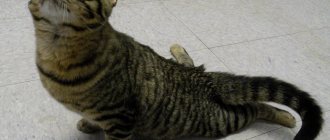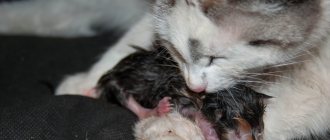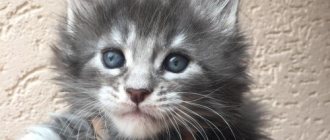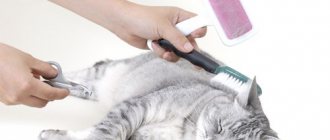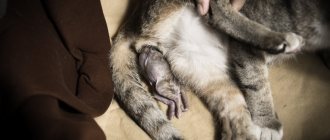Cats: alopecia associated with itching. Part 1
Causes of alopecia (baldness) in cats and other skin diseases: read part 2: Skin diseases and alopecia in cats not associated with itching
Hair loss in cats, lichen, demodicosis, hypotrichosis
Baldness of cats,
The appearance of hairless areas on your beloved cat is a common reason for visiting a veterinarian. The first thought that usually arises among owners is guard, lichen!!! Sometimes frightened owners can send an unfortunate animal to the street without trial... Meanwhile, there are a huge number of reasons for hair loss in cats, and we will try to talk about the most common ones: dermatophytosis, trichophytosis, microsporia (lichen).
What is alopecia?
This is an area on the skin that, for some reason, has lost its hair.
Types of alopecia in cats
Alopecia can be diffuse, focal and localized. Diffuse – when hair falls out abundantly and all over the body, partial – when in several areas. Localized - when only one area is affected.
Hair loss: spontaneous or self-induced
A very important point that you need to pay attention to for a correct diagnosis is whether the hair loss is independent or self-induced. Correctly self-induced alopecia is called “Spontaneous”, with this type of hair falling out on its own.
Self-induced or self-induced alopecia occurs from licking, for example, with itching and self-injury.
Due to constant grooming and constant licking, in some especially clean cats it is often not clear what kind of alopecia it is. Observing the cat helps most; the owner notices that the cat has begun to lick certain places intensively.
If some owners spend too much time outside the house or if cats hide, it can be difficult to understand. In this case, the doctor will take several hairs for a trichogram - analysis of hair under a microscope. Hairs that fall out on their own have bulbs at the end, but when you lick the hair on your own, it becomes injured and the ends look like broken off.
Sometimes in very difficult cases, for diagnosis, it is recommended to wear an “Elizabethan” collar, which makes self-licking impossible.
Determining what type of hair loss is significantly narrows down the list of differential diagnoses.
Hypotrichosis
There is also such a thing as hypotrichosis
- when the amount of hair on the skin area is reduced. Visually, it looks like a “bruised/moth-eaten” or like a thinning bald spot, when the skin is visible under the remnants of hair.
Possible causes of scabs along the spine
There are a large number of factors that provoke the development of sores in the spine in cats. The main ones are:
- Skin parasites - fleas, ticks, lice eaters. When biting through the skin, ectoparizites leave behind a wound surface. By scratching a wound that itches, the cat introduces pathogenic microflora and other types of infection into the wound, which provoke the development of the inflammatory process. As a result of this, bumps appear on the skin of the back.
- Allergic type reaction . A specific reaction of the body to foreign protein particles can provoke the formation of sores on the skin. Scabs along a cat's spine can occur in response to exposure to household chemicals, dust, and food. In addition to itching and sores on the skin, an allergic reaction causes a cat to cough, sneeze, and discharge from the nasal passages.
- Microsporia . A condition called ringworm can cause crusts to form on your cat's spine. Ringworm is characterized by the formation of dry crusts, which fall off when scratched and provoke the development of sores. Dermatophytosis spreads quickly and covers large areas of the skin.
- Demodectic mite is a disease that is more common in dogs than in cats. However, it can cause serious changes in the health of the animal, and in particular the skin. On the skin with demodicosis, specific crusts and areas of baldness are formed. Advanced cases of demodicosis cannot be treated and can also cause the death of a pet.
As a rule, the above-described causes of the formation of scabs along the spine provoke the development of pathological ulcerations throughout the body. The covers of the neck, auricle, tail and head are affected.
Causes of hair loss in cats
Dermatophytosis, trichophytosis, lichen
By far the most common disease leading to alopecia is dermatophytosis or lichen. Most often localized on the face and head. In cats, the disease is most often caused by fungi of the genus Microsporum canis. The main symptom is that the hairs fall out on their own and are pulled out very easily, because this is an infection of the hair follicle. Important! With dermatophytosis, itching is not a common symptom! Usually lichen does not itch.
The intensity of manifestation of this disease varies - the lesions can be localized (single) and focal (several) and a generalized form (many areas) with lost hair.
Predisposition to shingles in Persian cats
Persian cats have a breed predisposition to dermatophytosis. They often have chronic recurrent or generalized lichen. In them, this disease is often severe and is somewhat different in form from other breeds. They may also have areas of skin with peeling, but without obvious alopecia. Another form of the disease they have is severe inflammation and the formation of nodules in the skin.
Diagnosis of dermaphytosis
For the diagnosis of dermatophytosis
Previously, fluorescent diagnostics using a Wood's lamp were widely used. However, it has long been proven that this method gives a large amount of error and can only serve for an initial examination. Only some types of mushrooms (about 50%) give the classic apple-green glow. Not everything that glows in a Wood's lamp is ringworm, and vice versa - not everything that glows is ringworm. To confirm the diagnosis, skin scrapings and hair are taken from areas that glowed under a Wood's lamp or from non-luminous but questionable areas and examined under a microscope. If the hair is affected, you can see hair with a destroyed structure, sometimes with fungal spores.
In complex and doubtful cases, the doctor takes the culture into a test tube with a special medium. Unfortunately, the culture takes at least 10 days to prepare, so the doctor will most likely prescribe a trial treatment in this case, because the disease is also dangerous for humans.
Treatment of lichen in cats
If the diagnosis of dermatophytosis
the doctor will prescribe not only local treatments for the affected areas, but also an oral antifungal drug (most often, in cats, this is Itroconazole / Irunin, over a long course. This drug accumulates in the hair itself, preventing the disease from developing. Using only local remedies can lead to a chronic form illness, constant relapses and infection of the apartment with spores.
Remember! Vaccines against lichen (Microderm, Polivak, Vakderm, etc.) are not used in modern veterinary medicine, their effectiveness has not been proven.
IT IS FORBIDDEN!
Some drugs, used the old fashioned way, can do more harm than good! Yam ointment, for example, is simply poisonous to cats! The waste oil, which is still widely used in rural areas, is also poisonous. And treating the affected areas with iodine leads to chemical burns and the hair in such places may not grow back at all.
There are now many modern and safe remedies for the treatment of dermatophytosis, do not self-medicate!
Parasites. Demodecosis.
Demodexes
- These are skin parasites - mites that damage the hair follicle. Previously, it was believed that only dogs suffered from demodicosis, but two types of these mites have also been isolated in cats.
Feline demodicosis
Feline demodicosis is rare. Cats have 2 pathogens - Demodex cati or Demodex gatoi.
Differences between contagious and non-contagious demodicosis:
Demodex gatoi is contagious. Infection and manifestation can occur at any age. The lesions from this mite are itchy and we will see self-induced alopecia.
Demodex cati is not contagious. Normally, they are found in small quantities on the skin of a healthy animal, being opportunistic parasites.
It appears in adult cats; alopecia is spontaneous, that is, areas with fallen hair, without itching. The cause of the manifestation is usually serious immunity disorders - immunosuppression and other serious diseases, for example, diabetes.
The most common cat diseases
Parasites almost always cause itching, and the cat begins to lick and scratch vigorously. Skin lesions and self-induced alopecia appear. The most popular diseases include:
Notoedrosis
Notoedrosis is a lesion with unbearable itching, alopecia, severe scratching and scabs, most often localized on the head and neck.
Cheyletiellosis
Cheyletiellosis - or "wandering dandruff" - looks like flaking skin, there may be hypotrichosis and areas without hair.
Otodectosis
Otodectosis is an ear mite that causes severe itching in the head and alopecia of the ears and muzzle.
lice eaters
Lice eaters are parasites that also cause hair damage and, as a result, hair loss.
Treatment regimens
Only a veterinarian can accurately determine the causes of skin lesions after examining the animal. To make the diagnosis easier, the owner should observe the pet and write down all associated symptoms.
In addition to interviewing the owner, the veterinarian will conduct the necessary tests:
- blood analysis;
- biopsy;
- examination under a UV lamp;
- smears and scrapings of affected areas.
Treatment will depend on the causative agent of the disease and the location of the wounds. One of its treatment steps will be to relieve itching. But it should be borne in mind that this is only one of the symptoms, so it is important to determine the source of inflammation and eliminate it. Otherwise, when you stop taking the medication, the itching may only get worse, and sores that were only on the head and neck may spread throughout the body.
The selection of medications will depend on the identified problem:
- For fungal infections: long-term antifungal drugs (from several weeks to several months), but even this does not guarantee the absence of relapses. In addition, antibiotics and immunomodulators are used.
- In case of parasite infestations: first of all, antiparasitic treatment is carried out, and then measures are taken to treat wounds and scratches caused by flea bites.
- For eczema: antihistamines and sedatives, which can be supplemented with a vitamin complex.
- For allergies: antihistamines, and if a secondary bacterial infection occurs, antibiotics are added.
- If subcutaneous mites are detected: acaricides (selamectin, ivermectins, amitrazine) for at least 4 weeks, antimicrobial ointments, in some cases, glucocorticosteroids are added in the first stages to reduce itching.
Sources:
https://zen.yandex.ru/media/ivethelp/u-koshki-pod-sherstiu-boliachki-vozmojnye-prichiny-5d1af295c206ec00adecae20[
https://usatiki.ru/bolyachki-u-koshek-prichiny-i-lechenie/#i-8
Treating a cat for parasites
Treatment must be prescribed by a doctor. Most often, complex spot-on preparations (pipettes with medicine on the skin) are prescribed in an intensive mode - every 10-14 days. The most commonly used are “Stronghold” and “Inspector”. In case of skin infection, the doctor will prescribe local treatments with antiseptic solutions and even antibiotics. Recently, information has appeared about the effectiveness of the Bravecto tablet used in dogs in cats. Studies have already been conducted and safe doses for cats have been determined. However, there is no information in the instructions yet, but it will probably appear very soon.
Diagnosis and treatment
Sores in the back, and in particular the spine, are not recommended to be ignored. Thus, the owner of the animal must consult a veterinarian if any suspicious spots or crusts are detected on the body. Depending on the cause of the scab, the doctor will prescribe a therapeutic course taking into account individual characteristics.
To make an accurate diagnosis, the veterinarian prescribes a series of tests. The main ones are:
- general blood analysis;
- blood chemistry;
- examination of the affected areas of the skin under a special lamp (necessary if dermatophytosis is suspected);
- scraping from the affected areas for bacterial culture on nutrient media;
- biopsy (if a skin tumor is suspected in a cat).
If the cause of scabs along the spine is ectoparasites, special drugs are prescribed to destroy the parasites. The dosage and type of drug are prescribed by the attending physician. The resulting wound surfaces are treated with an antibacterial agent, which makes it possible to increase the process of skin regeneration and avoid the introduction of secondary microflora.
Scabs that arise due to an allergic type reaction must be treated comprehensively. First of all, it is necessary to identify the cause of the allergy.
If there is a food allergy, then suspicious ingredients are removed from the animal’s diet. If necessary, the doctor will prescribe and conduct special tests for allergens and prescribe adequate treatment. After identifying and eliminating the foreign protein component, new wounds on the skin will stop appearing, and old ones will disappear.
Veterinarians insist not to self-medicate at home. Self-prescribing medications without knowing the exact cause of the appearance of wounds and scabs on the skin can lead to dire consequences and even death (in case of drug overdose).
As a rule, treatment of scabs on the skin includes the use of antifungal agents, as well as medications that relieve inflammation. Demodectic mange diagnosed in a cat requires a special approach. A sick animal must be isolated from other cats and dogs, and the affected part of the coat must be cut off. Next, the skin is washed using special shampoos and aversictin ointment is applied. It is possible to use sulfur ointment and drops.
Red rash near the tail and along the back in cats
Hello!
There can be many reasons for the symptoms you describe. When did you perform routine deworming? What additional vitamin supplements do you use? This is very important diagnostic information. Please provide it as soon as possible.
Feed your animal either a high-quality commercial food: Acana, Gina, Orijen, Hills, Royal Canin, Eukanuba, Go Natural or Now Fresh. Or natural products: rice, oatmeal, buckwheat + beef, turkey, rabbit (not in the form of minced meat) and stewed vegetables (cabbage, cauliflower, carrots, beets). The percentage of meat in the main diet is at least 70%. Also remember that you should never mix natural food and industrial feed. Vitamins must be used for any type of diet, for 1-1.5 months. 2 r. in year.
The animal has allergies (due to not entirely correct nutrition), miliary dermatitis and, apparently, a staphylococcal infection. Perhaps hypovitaminosis also has a significant impact on the manifestation of this kind of symptomatology.
Treatment must be comprehensive.
- Normalize your diet. Use food without chicken meat in its composition and without the use of chicken fat.
- Instead of water - chamomile decoction 1 tsp. for 1 liter of water - up to 7-10 days.
- White coal 1 tablet or Ataxil 10-20 ml. ext. 2 r. in the village - up to 12 days. in 60 min. before or after meals and giving medications externally.
- Nux Vomica 3-4 drops. for 1 tsp. water int. 3 r. in the village - up to 7-10 days.
- Mezim 1/2 tablet. ext. 2 r. in the village - up to 10 days.
- Emprobio 3-4 ml ext. 2 r. in the village in 30 minutes. before meals - up to 14 days. or Hilak 5 drops. for 10 ml of water int. 2 r. in the village - up to 7-10 days.
- Salvikal or Vitabon for up to 3 months according to the instructions.
- Bathe the animal with TropiClean Oxy-Med Oatmeal Shampoo, treating the affected areas, then once every 1-2 months.
- Treat affected areas with hydrogen peroxide 2-3 times. in the village up to 14 days.
- Local treatment with Chlorhexidine 3 r. in the village up to 14 days
- Topically lubricate the affected areas with Methylene blue (alcohol solution), superficially, not too intensely, 2 r. in the village up to 12 days.
- 20 minutes after step No. 10, lubricate the affected areas with Clotrimazole or Ecodax 2 r. in the village up to 12 days.
- Wear a plastic protective veterinary collar for 30 days to prevent self-injury.
- Suprastin 0.3-0.4 ml i.m. 2 r. in the village up to 12 days.
- Lipoton 0.5 ml pc. 2 r. in the village up to 12 days.
Inform about the condition of the animal once every 3-5 days.
Health to your pets!
Best regards, Vetpraktika team




